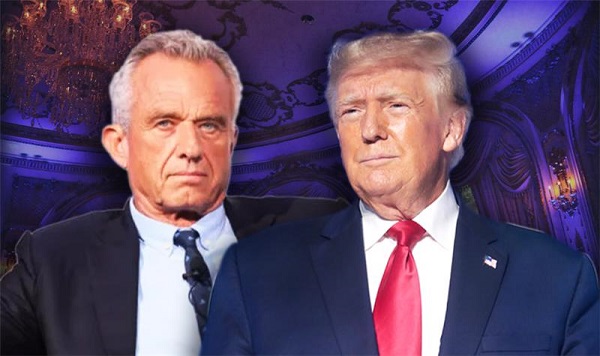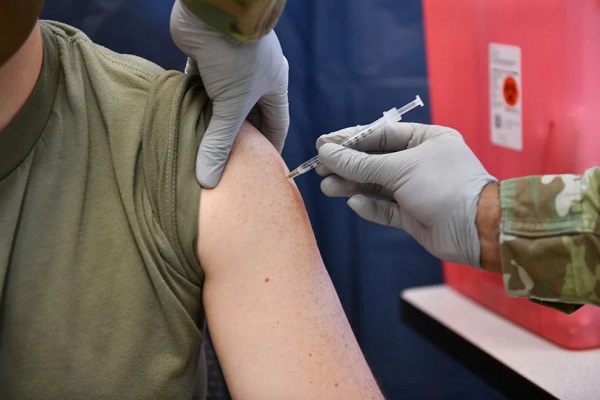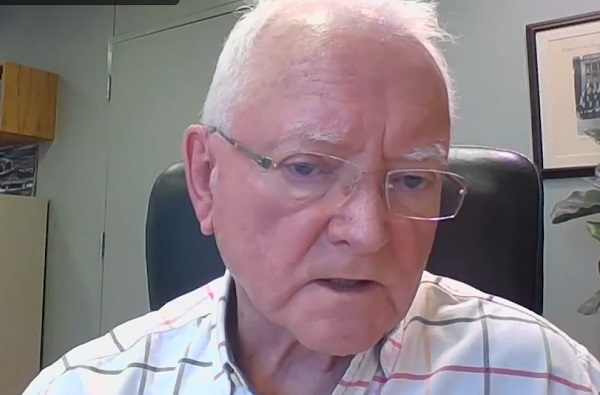Brownstone Institute
Opponents coordinating campaign to discredit RFK Jr.

From the Brownstone Institute
By
I’m not suggesting we accept every contrarian position, but rather that institutional credibility must be earned through rigorous analysis rather than assumed through authority.
As I often do on Sunday mornings, I was drinking my coffee and scrolling through my news feed when I noticed something striking. Maybe it’s my algorithm, but the content was flooded with an unusual amount of vitriol directed at Robert F. Kennedy, Jr.’s nomination as HHS Secretary. The coordinated messaging was impossible to miss—talking heads across networks uniformly labeling him a “conspiracy theorist” and “danger to public health,” never once addressing his actual positions. The media’s concerted attacks on Kennedy reveal more than just their opinion of his nomination—they expose a deeper crisis of credibility within institutions that once commanded public trust.
The Credibility Paradox
The irony of who led these attacks wasn’t lost on me—these were largely the same voices who championed our most destructive pandemic policies. As Jeffrey Tucker aptly noted on X :

The Coordinated Response
This hypocrisy becomes even more glaring in the New York Times’ recent coverage, where dismissive rhetoric consistently replaces substantive engagement. In one piece, they acknowledge troubling trends in children’s health while dismissively declaring “vaccines and fluoride are not the cause” without engaging his evidence. In another, Zeynep Tufekci—who notably advocated for some of the most draconian Covid measures—warns that Kennedy could “destroy one of civilization’s best achievements,” painting apocalyptic scenarios while sidestepping his actual policy positions.
Meanwhile, their political desk speculates about how his stance on Big Food might “alienate his GOP allies.” Each piece approaches from a different angle, but the pattern is clear: coordinated messaging aimed at undermining his credibility before he can assume institutional authority.

The Echo Chamber Effect
You can almost hear the editorial conveyor belt opening as senior editors craft the day’s approved reality for their audience. The consistent tone across pieces reveals less independent analysis than a familiar pattern—mockingbird media still in action. As I detailed in How The Information Factory Evolved, this assembly-line approach to reality manufacturing has become increasingly visible to anyone paying attention.
What these gatekeepers fail to grasp is that this smug dismissiveness, this refusal to engage with substantive arguments, is precisely what fuels growing public skepticism. Their panic seems to grow in direct proportion to Kennedy’s proximity to real power. This orchestrated dismissal is more than a journalistic flaw—it reflects a larger institutional dilemma, one that becomes unavoidable as Kennedy gains traction.
The Institutional Trap
The Times faces an emerging dilemma: at some point, they’ll need to address the substance of Kennedy’s arguments rather than rely on dismissive characterizations—especially if he assumes control of America’s health apparatus. Just this morning, MSNBC anchors were literally shouting that “Kennedy is going to get people killed”—yet another example of using melodramatics and fear instead of engaging with his actual positions. Their reflexive ridicule strategy backfires precisely because it avoids engaging with the evidence and concerns that resonate with parents and citizens across political lines. Each attempt to maintain narrative control through authority rather than evidence accelerates institutional credibility collapse.
Beyond Kennedy: Redrawing Political Lines
The NYT’s analysis about Kennedy potentially alienating GOP allies particularly highlights their fundamental misunderstanding of the shifting political landscape. As a lifelong Democrat who still champions many traditional progressive values, Kennedy transcends conventional political boundaries. His message—”We have to love our children more than we hate each other”—resonates precisely because anyone who dismisses this crusade to restore American vitality as mere political theater is blind to the groundswell of people who’ve grown tired of watching their communities crumble under the weight of manufactured decline.
This isn’t just about Kennedy—it’s about the media’s inability to address the legitimate concerns of a disillusioned public. When institutions refuse to engage with dissenting voices, they deepen mistrust and fracture the shared foundation necessary for democratic discourse. While RFK, Jr.’s message has resonated across political boundaries, the media’s inability to address core issues—like regulatory failures—reveals just how out of touch they’ve become.
The Art of Missing the Point
Consider this fact-check from the same article: The Times attempts to discredit Kennedy’s Fruit Loops example, but inadvertently confirms his central point: ingredients banned in European markets are indeed permitted in American products. By focusing on semantic precision instead of the broader issue—why US regulators allow unsafe ingredients—the media deflects from substantive debates.

Senator Elizabeth Warren declared this week: “RFK Jr. poses a danger to public health, scientific research, medicine, and health care coverage for millions. He wants to stop parents from protecting their babies from measles and his ideas would welcome the return of polio.” Yet this alarmist framing dodges the simple question Kennedy actually raises: Why wouldn’t you want proper safety testing for chemicals we’re expected to inject into our children’s bodies? The silence in response to this basic inquiry speaks volumes about institutional priorities—and their fear of someone with the power to demand answers.
A Referendum on Manufacturing Consent
Say what you want about Trump, but his “fake news” remarks struck a chord that resonates deeper with each passing day. People who once scoffed at these claims are now watching with eyes wide open as coordinated narratives unfold across media platforms. The gaslighting has become too obvious to ignore. As I explored in We Didn’t Change, The Democratic Party Did, this awakening transcends traditional political boundaries. Americans across the spectrum are tired of being told not to believe their own eyes, whether it’s about pandemic policies, economic realities, or the suppression of dissenting voices.
“The party told you to reject the evidence of your eyes and ears.
It was their final, most essential command.”
–George Orwell, 1984
The Moment of Truth
With Kennedy potentially overseeing America’s health infrastructure, media institutions face a crucial inflection point. Fear campaigns and ad hominem attacks won’t suffice when his policy positions require serious examination. The machinery of coordinated dismissal—visible in identical talking points across networks—reveals more about institutional allegiance than journalistic integrity.
This moment demands something different. When Kennedy raises questions about pharmaceutical safety testing or environmental toxins—issues that resonate with families across political lines—substantive debate must replace reflexive ridicule. His actual positions, heard directly rather than through media filters, often align with common-sense concerns about corporate influence on public health policy.
This institutional pattern of manufactured authority connects directly to themes I explored in Fiat Everything earlier this week—systems built on decree rather than demonstrated value. They don’t sell weapons—they sell fear. The same forces that control monetary policy now seek to dictate public health discourse.
Breaking the Machine
The solution won’t come from institutional gatekeepers (that’s what got us here) but direct examination. We all need to:
- Listen to Kennedy’s complete speeches rather than edited soundbites
- Read his policy positions rather than media characterizations
- Examine the evidence he cites rather than fact-checker summaries
- Consider why certain questions about public health policy are deemed off-limits
I’m not suggesting we accept every contrarian position, but rather that institutional credibility must be earned through rigorous analysis rather than assumed through authority. Until then, coverage like these recent Times pieces will continue to exemplify the very institutional failures that fuel the movements they seek to discredit. As Kennedy approaches real institutional power, expect these attacks to intensify—a clear signal of just how much the guardians of our manufactured consensus have to lose.
Republished from the author’s Substack
Brownstone Institute
If the President in the White House can’t make changes, who’s in charge?

From the Brownstone Institute
By
Who Controls the Administrative State?
President Trump on March 20, 2025, ordered the following: “The Secretary of Education shall, to the maximum extent appropriate and permitted by law, take all necessary steps to facilitate the closure of the Department of Education.”
That is interesting language: to “take all necessary steps to facilitate the closure” is not the same as closing it. And what is “permitted by law” is precisely what is in dispute.
It is meant to feel like abolition, and the media reported it as such, but it is not even close. This is not Trump’s fault. The supposed authoritarian has his hands tied in many directions, even over agencies he supposedly controls, the actions of which he must ultimately bear responsibility.
The Department of Education is an executive agency, created by Congress in 1979. Trump wants it gone forever. So do his voters. Can he do that? No but can he destaff the place and scatter its functions? No one knows for sure. Who decides? Presumably the highest court, eventually.
How this is decided – whether the president is actually in charge or really just a symbolic figure like the King of Sweden – affects not just this one destructive agency but hundreds more. Indeed, the fate of the whole of freedom and functioning of constitutional republics may depend on the answer.
All burning questions of politics today turn on who or what is in charge of the administrative state. No one knows the answer and this is for a reason. The main functioning of the modern state falls to a beast that does not exist in the Constitution.
The public mind has never had great love for bureaucracies. Consistent with Max Weber’s worry, they have put society in an impenetrable “iron cage” built of bloodless rationalism, needling edicts, corporatist corruption, and never-ending empire-building checked by neither budgetary restraint nor plebiscite.
Today’s full consciousness of the authority and ubiquity of the administrative state is rather new. The term itself is a mouthful and doesn’t come close to describing the breadth and depth of the problem, including its root systems and retail branches. The new awareness is that neither the people nor their elected representatives are really in charge of the regime under which we live, which betrays the whole political promise of the Enlightenment.
This dawning awareness is probably 100 years late. The machinery of what is popularly known as the “deep state” – I’ve argued there are deep, middle, and shallow layers – has been growing in the US since the inception of the civil service in 1883 and thoroughly entrenched over two world wars and countless crises at home and abroad.
The edifice of compulsion and control is indescribably huge. No one can agree precisely on how many agencies there are or how many people work for them, much less how many institutions and individuals work on contract for them, either directly or indirectly. And that is just the public face; the subterranean branch is far more elusive.
The revolt against them all came with the Covid controls, when everyone was surrounded on all sides by forces outside our purview and about which the politicians knew not much at all. Then those same institutional forces appear to be involved in overturning the rule of a very popular politician whom they tried to stop from gaining a second term.
The combination of this series of outrages – what Jefferson in his Declaration called “a long train of abuses and usurpations, pursuing invariably the same Object” – has led to a torrent of awareness. This has translated into political action.
A distinguishing mark of Trump’s second term has been an optically concerted effort, at least initially, to take control of and then curb administrative state power, more so than any executive in living memory. At every step in these efforts, there has been some barrier, even many on all sides.
There are at least 100 legal challenges making their way through courts. District judges are striking down Trump’s ability to fire workers, redirect funding, curb responsibilities, and otherwise change the way they do business.
Even the signature early achievement of DOGE – the shuttering of USAID – has been stopped by a judge with an attempt to reverse it. A judge has even dared tell the Trump administration who it can and cannot hire at USAID.
Not a day goes by when the New York Times does not manufacture some maudlin defense of the put-upon minions of the tax-funded managerial class. In this worldview, the agencies are always right, whereas any elected or appointed person seeking to rein them in or terminate them is attacking the public interest.
After all, as it turns out, legacy media and the administrative state have worked together for at least a century to cobble together what was conventionally called “the news.” Where would the NYT or the whole legacy media otherwise be?
So ferocious has been the pushback against even the paltry successes and often cosmetic reforms of MAGA/MAHA/DOGE that vigilantes have engaged in terrorism against Teslas and their owners. Not even returning astronauts from being “lost in space” has redeemed Elon Musk from the wrath of the ruling class. Hating him and his companies is the “new thing” for NPCs, on a long list that began with masks, shots, supporting Ukraine, and surgical rights for gender dysphoria.
What is really at stake, more so than any issue in American life (and this applies to states around the world) – far more than any ideological battles over left and right, red and blue, or race and class – is the status, power, and security of the administrative state itself and all its works.
We claim to support democracy yet all the while, empires of command-and-control have arisen among us. The victims have only one mechanism available to fight back: the vote. Can that work? We do not yet know. This question will likely be decided by the highest court.
All of which is awkward. It is impossible to get around this US government organizational chart. All but a handful of agencies live under the category of the executive branch. Article 2, Section 1, says: “The executive Power shall be vested in a President of the United States of America.”

Does the president control the whole of the executive branch in a meaningful way? One would think so. It’s impossible to understand how it could be otherwise. The chief executive is…the chief executive. He is held responsible for what these agencies do – we certainly blasted away at the Trump administration in the first term for everything that happened under his watch. In that case, and if the buck really does stop at the Oval Office desk, the president must have some modicum of control beyond the ability to tag a marionette to get the best parking spot at the agency.
What is the alternative to presidential oversight and management of the agencies listed in this branch of government? They run themselves? That claim means nothing in practice.
For an agency to be deemed “independent” turns out to mean codependency with the industries regulated, subsidized, penalized, or otherwise impacted by its operations. HUD does housing development, FDA does pharmaceuticals, DOA does farming, DOL does unions, DOE does oil and turbines, DOD does tanks and bombs, FAA does airlines, and so on It goes forever.
That’s what “independence” means in practice: total acquiescence to industrial cartels, trade groups, and behind-the-scenes systems of payola, blackmail, and graft, while the powerless among the people live with the results. This much we have learned and cannot unlearn.
That is precisely the problem that cries out for a solution. The solution of elections seems reasonable only if the people we elected actually have the authority over the thing they seek to reform.
There are criticisms of the idea of executive control of executive agencies, which is really nothing other than the system the Founders established.
First, conceding more power to the president raises fears that he will behave like a dictator, a fear that is legitimate. Partisan supporters of Trump won’t be happy when the precedent is cited to reverse Trump’s political priorities and the agencies turn on red-state voters in revenge.
That problem is solved by dismantling agency power itself, which, interestingly, is mostly what Trump’s executive orders have sought to achieve and which the courts and media have worked to stop.
Second, one worries about the return of the “spoils system,” the supposedly corrupt system by which the president hands out favors to friends in the form of emoluments, a practice the establishment of the civil service was supposed to stop.
In reality, the new system of the early 20th century fixed nothing but only added another layer, a permanent ruling class to participate more fully in a new type of spoils system that operated now under the cloak of science and efficiency.
Honestly, can we really compare the petty thievery of Tammany Hall to the global depredations of USAID?
Third, it is said that presidential control of agencies threatens to erode checks and balances. The obvious response is the organizational chart above. That happened long ago as Congress created and funded agency after agency from the Wilson to the Biden administration, all under executive control.
Congress perhaps wanted the administrative state to be an unannounced and unaccountable fourth branch, but nothing in the founding documents created or imagined such a thing.
If you are worried about being dominated and destroyed by a ravenous beast, the best approach is not to adopt one, feed it to adulthood, train it to attack and eat people, and then unleash it.
The Covid years taught us to fear the power of the agencies and those who control them not just nationally but globally. The question now is two-fold: what can be done about it and how to get from here to there?
Trump’s executive order on the Department of Education illustrates the point precisely. His administration is so uncertain of what it does and can control, even of agencies that are wholly executive agencies, listed clearly under the heading of executive agencies, that it has to dodge and weave practical and legal barriers and land mines, even in its own supposed executive pronouncements, even to urge what might amount to be minor reforms.
Whoever is in charge of such a system, it is clearly not the people.
Brownstone Institute
The New Enthusiasm for Slaughter

From the Brownstone Institute
By
What War Means
My mother once told me how my father still woke up screaming in the night years after I was born, decades after the Second World War (WWII) ended. I had not known – probably like most children of those who fought. For him, it was visions of his friends going down in burning aircraft – other bombers of his squadron off north Australia – and to be helpless, watching, as they burnt and fell. Few born after that war could really appreciate what their fathers, and mothers, went through.
Early in the movie Saving Private Ryan, there is an extended D-Day scene of the front doors of the landing craft opening on the Normandy beaches, and all those inside being torn apart by bullets. It happens to one landing craft after another. Bankers, teachers, students, and farmers being ripped in pieces and their guts spilling out whilst they, still alive, call for help that cannot come. That is what happens when a machine gun opens up through the open door of a landing craft, or an armored personnel carrier, of a group sent to secure a tree line.
It is what a lot of politicians are calling for now.
People with shares in the arms industry become a little richer every time one of those shells is fired and has to be replaced. They gain financially, and often politically, from bodies being ripped open. This is what we call war. It is increasingly popular as a political strategy, though generally for others and the children of others.
Of course, the effects of war go beyond the dismembering and lonely death of many of those fighting. Massacres of civilians and rape of women can become common, as brutality enables humans to be seen as unwanted objects. If all this sounds abstract, apply it to your loved ones and think what that would mean.
I believe there can be just wars, and this is not a discussion about the evil of war, or who is right or wrong in current wars. Just a recognition that war is something worth avoiding, despite its apparent popularity amongst many leaders and our media.
The EU Reverses Its Focus
When the Brexit vote determined that Britain would leave the European Union (EU), I, like many, despaired. We should learn from history, and the EU’s existence had coincided with the longest period of peace between Western European States in well over 2,000 years.
Leaving the EU seemed to be risking this success. Surely, it is better to work together, to talk and cooperate with old enemies, in a constructive way? The media, and the political left, center, and much of the right seemed at that time, all of nine years ago, to agree. Or so the story went.
We now face a new reality as the EU leadership scrambles to justify continuing a war. Not only continuing, but they had been staunchly refusing to even countenance discussion on ending the killing. It has taken a new regime from across the ocean, a subject of European mockery, to do that.
In Europe, and in parts of American politics, something is going on that is very different from the question of whether current wars are just or unjust. It is an apparent belief that advocacy for continued war is virtuous. Talking to leaders of an opposing country in a war that is killing Europeans by the tens of thousands has been seen as traitorous. Those proposing to view the issues from both sides are somehow “far right.”
The EU, once intended as an instrument to end war, now has a European rearmament strategy. The irony seems lost on both its leaders and its media. Arguments such as “peace through strength” are pathetic when accompanied by censorship, propaganda, and a refusal to talk.
As US Vice-President JD Vance recently asked European leaders, what values are they actually defending?
Europe’s Need for Outside Help
A lack of experience of war does not seem sufficient to explain the current enthusiasm to continue them. Architects of WWII in Europe had certainly experienced the carnage of the First World War. Apart from the financial incentives that human slaughter can bring, there are also political ideologies that enable the mass death of others to be turned into an abstract and even positive idea.
Those dying must be seen to be from a different class, of different intelligence, or otherwise justifiable fodder to feed the cause of the Rules-Based Order or whatever other slogan can distinguish an ‘us’ from a ‘them’…While the current incarnation seems more of a class thing than a geographical or nationalistic one, European history is ripe with variations of both.
Europe appears to be back where it used to be, the aristocracy burning the serfs when not visiting each other’s clubs. Shallow thinking has the day, and the media have adapted themselves accordingly. Democracy means ensuring that only the right people get into power.
Dismembered European corpses and terrorized children are just part of maintaining this ideological purity. War is acceptable once more. Let’s hope such leaders and ideologies can be sidelined by those beyond Europe who are willing to give peace a chance.
There is no virtue in the promotion of mass death. Europe, with its leadership, will benefit from outside help and basic education. It would benefit even further from leadership that values the lives of its people.
-

 2025 Federal Election2 days ago
2025 Federal Election2 days agoLiberals Replace Candidate Embroiled in Election Interference Scandal with Board Member of School Flagged in Canada’s Election Interference Inquiry
-

 Alberta2 days ago
Alberta2 days agoIs Canada’s Federation Fair?
-

 Alberta1 day ago
Alberta1 day agoProvince introducing “Patient-Focused Funding Model” to fund acute care in Alberta
-

 espionage2 days ago
espionage2 days agoU.S. Experts Warn Canada Is Losing the Fight Against PRC Criminal Networks—Washington Has Run Out of Patience
-

 COVID-191 day ago
COVID-191 day agoMassive new study links COVID jabs to higher risk of myocarditis, stroke, artery disease
-

 Alberta1 day ago
Alberta1 day agoMedical regulator stops short of revoking license of Alberta doctor skeptic of COVID vaccine
-

 International1 day ago
International1 day agoUN committee urges Canada to repeal euthanasia for non-terminally ill patients
-

 Automotive2 days ago
Automotive2 days agoTesla Vandals Keep Running Into The Same Problem … Cameras







